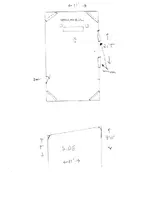Actually the void behind a bass trap is very important from what I have read about the topic. Yes, it has been stated many times by the guys that do this room treatment for a living, that filling the gap behind a corner trap with fluffy is more effective than the 'superchunk' approach. The biggest issue seems to be holding up the fluffy stuff.
Bass traps always perform better with an air gap behind them. It is normally the limitations of the size of a room that stops most from being able to hang wall absorbers another 4" into their space (absorbers on the walls). As far as corner traps go, the most commonly used method seems to be a 2'x4'x4" thick panel straddling the corner. I found that the same width/thickness from floor to ceiling works much better in my space. I have not filled the space behind them as one of my corners is a doorway, so I need the panel to be portable. Symmetry is also a consideration, so I just left it as it is. When I built the full length panels, I had a few too many beers, and forgot to add the Kraft paper to the face before covering with fabric. I even bought the stuff... Not sure if it would have made much difference, but I was informed it would help some. Anyway, the difference of a full length panel sounded obvious to me, and anything is way better than none at all.
Also, do not forget that wall to ceiling is also a corner and that can be treated in the same way while conserving valuable space. Just hanging them becomes the issue. Not a big deal if you own your property. Landlords not going to like holes for anchors needed to hold up bass traps from the ceiling.
I am about ready to build a new isolation room that will include wall/ceiling bass traps. The space is a bit small (16X13X8' I think) and I want to keep it a bit live sounding. Just not the low end buildup. I will surely be back to this forum for advice from the ones who know their shiz.


